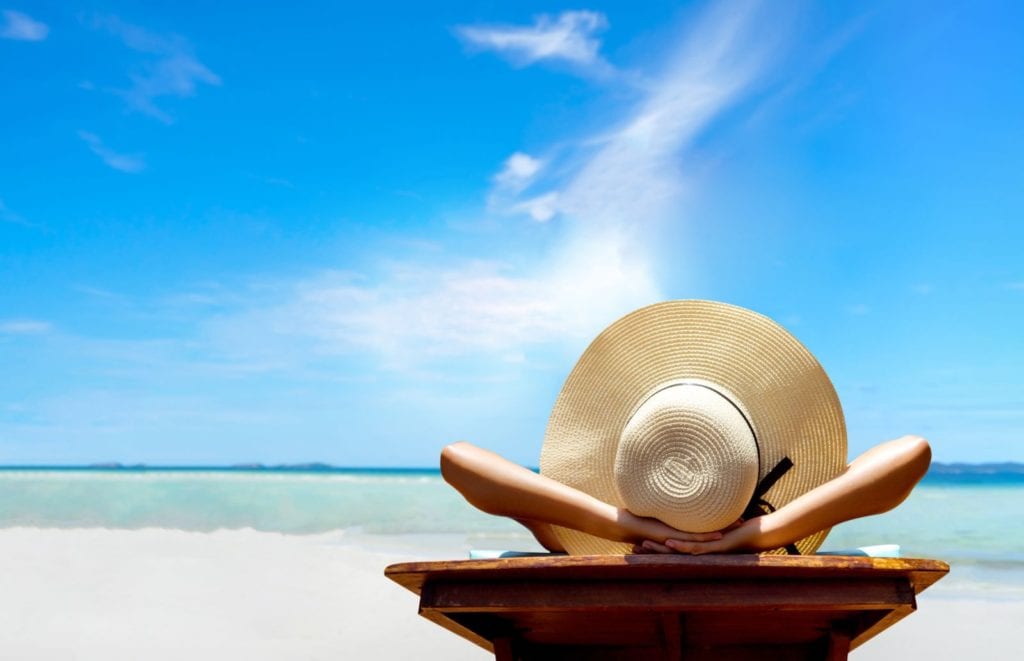It’s well known that Australia has one of the highest rates of skin cancer in the world. Add to that the growing awareness of the aging impact that the sun can have on your skin, and you can understand why more and more people are choosing to wear sun protection every day.
However, when it comes to choosing a sunscreen it can be hard to know where to start. This is the first in a series of 3 articles which will help you better understand how to protect your skin from the sun. In the upcoming articles we’ll also look at sustainability and ethical considerations, and we’ll also look at which ingredients are kindest to your skin.
Read on for a deep dive….this is a lengthy article, however, it’s an important topic!
Let’s start with the sun’s rays:
Solar UVR (Ultraviolet radiation) is invisible energy produced by the sun. It’s made up of three wavelengths, UVA, UVB and UVC. Both UVA and UVB can reach the earth’s surface and are classified as human carcinogens. This means they cause cancer.
UVA – The portion of the sun’s UV spectrum with wavelengths in the range of 320-400 nanometres. Penetrates the skin more deeply than UVB, considered to be responsible for longer term damage resulting in melanomas and skin cancers.
UVB – The portion of the sun’s UV spectrum with wavelengths in the range of 290-320 nanometres. Mainly responsible for sunburn.
The term ‘broad spectrum’ means that the sunscreen protects your skin from both UVB and UVA radiation. Sunscreens that are not broad spectrum only protect against UVB radiation. Of course, the SPF level of your sunscreen is also very important….
What is an SPF?
Sun Protection Factor. According to the Australian Radiation and Protection, a sunscreen’s SPF rating indicates “the level of protection provided against UVR. It’s the ratio of the UVR dose someone would receive without sunscreen to that received with a carefully applied sunscreen”. [1]
The following table[2] shows the amount of UVR (ultraviolet radiation) blocked out for a given SPF rating:
| SPF | % of UVR blocked |
| 4 | 75 |
| 8 | 87.5 |
| 15 | 93.3 |
| 30 | 96.7 |
| 50 | 98 |
The Cancer Council Australia recommends using an SPF30 or higher, that is high spectrum and water resistant[3].
What else do I need to know about SPF?
- The Australian Standard for sunscreens allows a sun protection factor (SPF) rating of up to 50+, which filters 98% of UV radiation in comparison to SPF30, which filters 96.7%[4]
- The plus sign means that the SPF rating is higher than the number. For example, a sunscreen with an SPF of 50+ must have an SPF of 60 or more
- You will only be protected to the level of the highest SPF level you are wearing. If you apply a moisturiser with SPF15, followed by a sunscreen with SPF20 – you will be protected to a level of SPF20 (not SPF35).
When and how to apply sunscreen:
The Cancer Council recommends that:
- sunscreen be applied at least 20 minutes before going outdoors
- you should reapply every two hours if you are spending time outdoors and after being in the water
- Regardless of the type of sunscreen you choose, Cancer Council recommends that you apply liberally every two hours – at least a teaspoon for each limb, front and back of the body and half a teaspoon for the face, neck and ears. You should apply one cupped adult hand (30 to 40 ml) of sunscreen for an adult body.
Some other tips include:
- check that your sunscreen is within its use-by-date and store below 30°C
- if you are going to wear sunscreen and moisturisers or cosmetics, it’s best to apply your sunscreen first – on dry, clean skin.
Regulation of sunscreen ingredients and formulations in Australia:
We’re fortunate to have a very well-regulated sunscreen industry in Australia. The Therapeutic Goods Administration (TGA) regulates sunscreens ensuring that only approved ingredients, including chemicals, which have been assessed for quality and safety are used in each product. Regardless of what type of sunscreen you chose to protect your skin, the Cancer Council recommends using a TGA approved product.
Choosing a sunscreen:
Sunscreens contain substances that either absorb or reflect the sun’s UV rays and prevent most of it from penetrating the skin and damaging skin cells.
Sunscreens fall into two different categories:
- Chemical sunscreens – absorb UVR. Simply put, chemical sunscreens are those that contain chemicals which absorb UVR. Common chemical ingredients include: Octylcrylen, Avobenzone and Octinoxate
- Physical sunscreens – they form a protective layer on the skin and reflect and scatter UVR. Many organic and/or natural sunscreens will often use a physical blocker such as zinc, to help protect against UVR. Physical sunscreens use natural agents like zinc and titanium oxide. The physical ones are reflectorsand they do just that: they form a protective layer on the skin and reflect those UV rays
Both sunscreen kinds are effective (when applied correctly) in protecting your skin from the sun, and safe. The TGA has reviewed extensive research. Choose one that best suits your skin type and activity, and that you find easy to apply. If you have sensitive skin or have a reaction to a product, there are fragrance-free or sensitive formula sunscreens available. Or, if you have particular concerns about specific ingredients than that’s where we might be able to help.
How can we help?
We stock a range of sunscreens, for all ages. If you are concerned about the ingredients in your sunscreen then visit us instore – we are here to help.
We screen the ingredients to ensure that they meet our standards:
- We run the ingredients against our ingredients standards list
- sustainable packaging
- ingredients which won’t harm our reefs
- We also stock sunscreens which have been developed for the most sensitive of skins
Visit us in-store or shop online to check out our range.
Finally…
And remember, as the Cancer Council notes “sunscreen use is one of five important ways of reducing the risk of skin cancer”[5]. The other 4 are:
- Sun protective clothing. For walking outdoors, I use an SPF 50+ bamboo/cotton long-sleeved shirt from Solbari. It has hand-covers, is lightweight and washes easily
- Always wear a hat
- Wear your sunglasses outside and lastly;
- Seek out shade as much as possible when outdoors.
The Cancer Council Australia has a wealth of information and you can check out their website for more tips.
[1] ARPANSA – The Australian Radiation Protection and Nuclear Safety Agency https://www.arpansa.gov.au/understanding-radiation/radiation-sources/more-radiation-sources/sun-protection-sunscreen
[2] ARPANSA https://www.arpansa.gov.au/understanding-radiation/radiation-sources/more-radiation-sources/sun-protection-sunscreen
[3] Cancel Council Australia https://www.cancer.org.au/preventing-cancer/sun-protection/about-sunscreen.html
[4] TGA https://www.tga.gov.au/community-qa/sunscreens-information-consumers
[5] Cancel Council cancer.org.au


